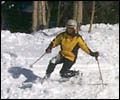

The Evolution of the Tele Binding
From Crunchy Pin-Head to Lift-Aided Tech-Weenie Traditional "pin-heads" will have some trouble maintaining their retro image if the new wave of telemark bindings is any indication of where things are headed.
 Telemark Skiing |
|
And it's about time.
The old pin-head look — wool pants (or even knickers with long, wool knee socks), shoulder high poles with baskets the size of trash can lids, an alpaca hat, dreadlocks, Vuarnets, and "nordic" skis with classic, three-pin bindings (no cables) can still be found, but it's a bit of a dinosaur.
More likely, especially in lift lines at resorts, you'll find this MO: shiny, sleek, new Black Diamond Skyhoys resting on fire-engine red Atomic Beta Ride 24s; beefy plastic Terminator boot; Goretex-encased skier wearing a "Herminator" racing helmet; composite titanium poles, or some such configuration.
|
|
|
|
|
|
|
|
| "Ah, progress. For better or worse, the three-pin system is going the way of the 8-track, the typewriter, and the floppy disk..." |
|
|
|
|
|
|
|
|
Prospective tele shredders, once they've dealt with boot and ski combinations and considerations, are left with the daunting task of choosing a binding — and it's not that easy. It's a complex topic that comes down to a few central considerations: perceived usage, release versus non-release, and of course net worth — what's it gonna cost ya?
In part, telemark boot manufacturers have driven certain changes in the binding market, because many (if not most) tele skiers are now running plastic boots. Plastic's torsional rigidity and power creates stresses on bindings not achieved a decade ago in leather boots, and bindings have been beefed up to handle the strain, in many cases moving from aluminum to stainless steel.
 Voilé Three-Pin Cable |
|
|
|
|
|
|
|
|
|
| "Plastic's torsional rigidity and power creates stresses on bindings not achieved a decade ago in leather boots..." |
|
|
|
|
|
|
|
|
Ah, progress. For better or worse, the three-pin system is going the way of the 8-track, the typewriter, and the floppy disk. Most binding manufacturers have moved away from the three-pin system, opting instead for a straight-cable system with slide-in toe piece. And while these bindings do offer relative ease of entry (pins are the most cumbersome to get in and out of, and the toe holes often fill up with ice or snow, and pins are notorious for tearing up boot soles), they do not provide a backup system, so you had better bring along extra cables, nuts, and bolts in case of failure. Or at the very least a big roll of duct tape!
For backcountry uses, Voilé still sets the old-fashioned standard: a lightweight redundant system that also comes with a release package, if you so desire. The side heel throw is easy to operate, and the cables remove and adjust effortlessly. They are also among the most affordable on the market at only $79.00 for the Three-Pin Cable.
 Voilé Classic Cable |
|
Other popular cable systems include The Riva 2 (Black Diamond), The Pitbull 2 (Black Diamond), The Rottefella/Black Diamond Chili, the Rainey SuperLoop, and the G3 Targa. All of these are fairly similar: they offer pin-less toe pieces with a heel-throw cable. Personal choice will dictate which is the option you want — all have their idiosyncratic pros and cons. Bottom line again: bring extra cables and hardware for backcountry applications.
The Release Conundrum
When do you want your binding to release? A) In a catastrophic egg-beater; B) In an avalanche; C) When you are upside down in a tree well. By the way, you should try very hard to avoid all of the above situations.
To release or not to release, that is the question. At this time, few release choices exist, so it isn't that much of a brain twister. The pros of the release systems on the market include avoiding potential injury, something that is bound to increase with the newer, burlier/stiffer, higher, more alpine-like boots and cable-bound bindings. That is their main benefit. Also, the current release systems offer compatibility with many bidings that use the three-hole mounting pattern, such as Voilé, Riva, and Chili. Ultimately, if you are a learning skier destined to auger a lot, or one who skis exceedingly fast, release bindings aren't a bad idea.
|
"Backcountry aficionados who have a disdain for lifts,
one-piece Bogner suits, and warming huts ... usually opt for lighter gear, and that includes
bindings..." |
Currently, the release world is ruled by two major manufacturers, Voilé and Rottefella, with a third, the just-released (pun intended) Black Diamond Skyhoy, to be truly tested this season (more on the Skyhoy in a moment).
The Voilé CRB is the only releasable binding with any real history (about a decade), so it has become the go-to release binding. The Voilé is basically the three-pin cable mounted on a release plate, with its main release function actuated laterally, at the toe, and sometimes upward. Again, ice and powder can gum up the reload: this is simply the nature of the beast. Live with it and bring a Leatherman tool.
The Rottefella TRP 100 offers a DIN rated (DIN-Deutschland Industry Norms, determines release ratings for Alpine bindings) with the entire unit residing underfoot, which is nice because unlike the Voilé, the system doesn't ride way out in front of the toe, altering the swing weight of the skis.
 Black Diamond Skyhoy |
|
The Skyhoy heralds the beginning of a new era, and definitely a new look. The binding looks quite like an alpine binding, and indeed you step in and click down your heel in the same way as an alpine binding. They remain "free heel" because of a clever (yet still untested over time) double joint and bridge system under the boot that follows the boot's flex in the tele turn. Presumably, reliable release occurs through their spring-loaded, sliding-heel carriage. The Skyhoy comes complete with the most shocking price on the market ($325.00 alone, add $60.00 for the ski brake kit). They are also very heavy, weighing in at nearly four pounds.
The step-in feature is one long coveted by tele skiers, and while Black Diamond was first to market the concept, there are a bunch more in the works. Word has it that Karhu is testing a binding for introduction in 2001. Ichor Rocket Science unveiled a binding at last year's OR Show, but it has yet to surface. Rossignol is apparently working on a new binding system, and a number of independent designers are working on, or even have, functional prototypes.
 Landmark Sports SRBT |
|
Armond DuBuque, founder of the patented Ultimate Telemark Company based in Sultan, Washington, was motivated to create a binding because he wasn't satisfied with anything else that was out there. His Ultimate Telemark Binding is adaptable to most release plates, and the dual-purpose toe plate also functions as a crampon. "The most important thing is to have something solid that won't break on people in the backcountry," said DuBuque, who is in the third year of testing his step-in system and currently has 40 pairs in the field.
While all of this looks to spell the end of the traditional tele binding as we have known it, the phase-out period for other binding systems should last quite some time, perhaps even a decade. People just are not that keen to toss out perfectly useful bindings, even if their buddies are riding the next big thing.
Step-in releasable — it's where we're headed in the long run.
So, next time you see an alpaca-domed, dreadlocked tele skier in leather boots who double poles in the turn, snap a picture. You'll be recording a relic.
—Buddy Levy, MountainZone.com Correspondent